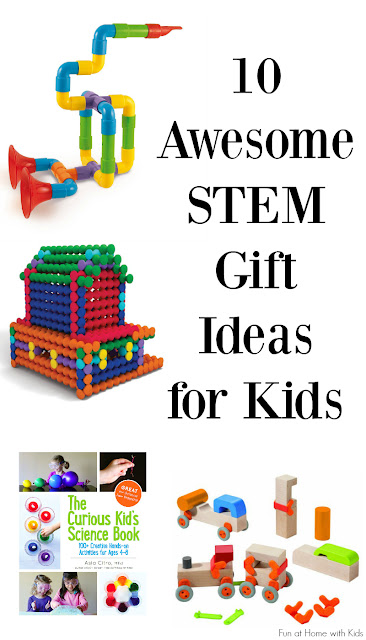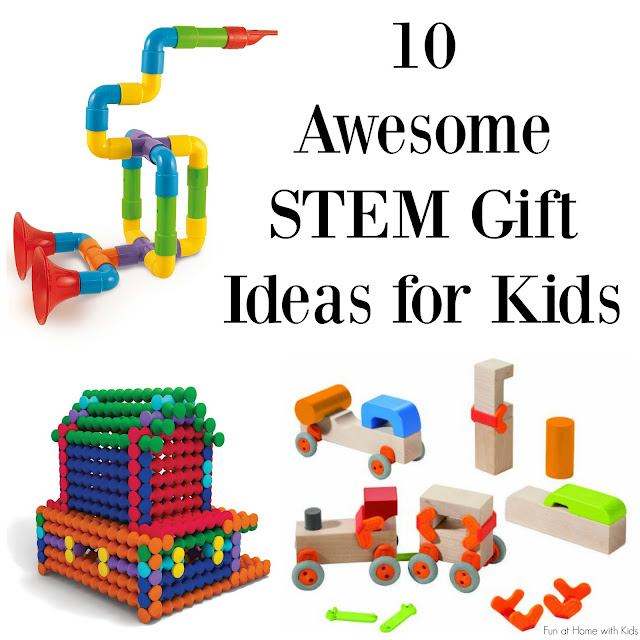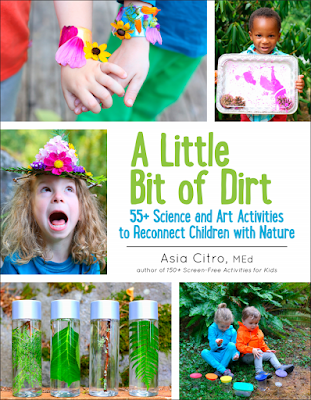Every year I try to add a new gift guide that focuses on something new. You can also find lists of the Best Gifts on a Budget, our Favorite Gifts for Kids, our Favorite Books for Kids, and our Favorite Art Supplies for Kids here on the site. This year we've really been all about STEM (Science, Technology, Engineering, and Mathematics) at our house, in large part because of the release of our new science book, but also because I'm a science teacher! So I thought I'd focus on a science gift theme for 2015. :)
This post contains affiliate links for your convenience.
Images courtesy of Amazon.com unless otherwise noted.
In no particular order, here are our favorite STEM-building toys. Because learning through play is the BEST!!!!
Quercetti Saxoflute
Ideal ages: Toddler and up
I LOVE this toy. Not only is it very easy to make it whistle (sooo nice for toddlers who are learning how to blow to make a whistle or horn make noise), but it's not super loud and it's incredibly fun to create crazy instruments, even for us adults. :)
What they are learning: How different configurations change the sound/pitch of the instrument, how to troubleshoot (if their horn isn't making noise), how an instrument works, how the movement and force of air changes sound
HABA Technic Blocks - Basic Vehicles
Ideal ages: Preschool and up
Kids can create all sorts of different vehicles (cars, trains, trucks, and more) with this toy. It's a great imaginative exercise as well as a playful way to learn some physics and engineering!
What they are learning: Where to place wheels and connectors to make a functioning vehicle (engineering), how different configurations of vehicles change how easy/quickly the vehicle moves (physics)
The Curious Kid's Science Book
Ideal ages: Preschool through second grade
In our newest book, kids will learn how to run their own experiments to answer scientific questions. They'll learn from failed experiments and learn more about the world around them (via real-world connections offered throughout the book). The book's 100+ activities playfully build on children's natural science, math, engineering, and technology skills using mainly normal household ingredients.
What they are learning: How to conduct an experiment, how to use scientific tools, real-life concepts, perseverance and patience, very basic biology, chemistry, and physics
Tinkerlab
Ideal ages: Toddler through second grade
Tinkerlab has 55+ activities that encourage tinkering, curiosity, and creative thinking from Rachelle Doorley of Tinkerlab.com. This book is a great way to get kids inventing!
What they are learning: Engineering, tinkering, and inventing skills, perseverance and patience
Playstix
Ideal ages: Preschool and up
These are really interesting building blocks - I like to think of them as a much cooler version of the Lincoln Logs I had growing up. They rest on each other, like Lincoln Logs, but can also snap together in certain configurations, and also have the added bonus of wheels that work to make rolling cars, planes, and more!
What they are learning: Where to place wheels and connectors to make a functioning vehicle (engineering), how different configurations of vehicles change how easy/quickly the vehicle moves (physics), how to create a stable structure/building
Snap Circuits
Ideal ages: Preschool and up
These things are amazing! They are classified as ages 8+, but if you are willing to sit with your child while they work through these activities, I've found that kids around 4-5 years old can easily play with these and learn a ton. I also love that you can creatively use the pieces to invent your own circuits!
What they are learning: Beginning circuitry!
Raise a Butterfly
Image courtesy of Shady Oak Butterfly Farm
Ideal ages: Preschool and up
This activity is most ideal for spring/summer, but it's such a wonderful (and beloved) activity, that you could always gift a certificate for the kit to be used later. There are many ways to raise butterflies, but my favorite are the kits from Shady Oak Butterfly Farm because they send you actual host plants. You will need to keep the host plant alive, and because your caterpillars are feeding on actual plants, there are usually slightly fewer caterpillars than the store-bought kits. I love that they also send you seeds to plant host plants for the butterflies in your state. As a science teacher, I love that kids get to learn the added information about host plants and it's really cool to watch the caterpillars eat through the leaves!
What they are learning: Basic biology -- host plants, butterfly life cycle
If you're on a budget or don't want the added responsibility of caring for host plants, these kits are also quite fun.
Straws and Connectors
Ideal ages: Toddler and up
Most toddlers won't have the fine motor skills to be able to build with these, but they will have plenty of fun playing in the things you create for them. I love that these are just as fun for us as for our kids. We've made balls that roll, houses, boats, cars, towers, and even the Eiffel Tower with ours.
What they are learning: Basic engineering (how to create a stable structure), patience and perseverance
Stereo Microscope
Ideal ages: Kindergarten and up
A microscope is a big investment, but it's one that can grow with your child. I am a very big proponent of purchasing a stereo microscope vs compound (or regular) microscopes. Regular microscopes magnify a TON (which can be kind of overwhelming for little ones who don't quite understand what they are looking at anymore because it looks SO different) and they also require thin slices of flat items. They are challenging for little ones to focus - often because they really aren't sure what they should be looking for. Stereo microscopes (also called dissecting microscopes) are my favorites with little guys because you can look at darn near anything. Your finger? Sure! A toy? Absolutely! A worm? Totally. As long as you can fit it under your microscope, you're almost sure to be able to see it. It does not need to be flat or thinly sliced. It magnifies a lot, but not so much that you can no longer tell what you're looking at. My daughter got hers at age 5 and could reliably focus on items herself because it's so much easier to tell what you're looking for! You can still look at slides if you'd like, but you aren't limited to slides. Here are two versions of stereo microscopes (one is less expensive because it offers less magnification; we have this one which offers more magnification -- both are great microscopes though):
What they are learning: About magnification and the structure of various items
Kinetic Sand
Ideal ages: Toddler and up
Even something as simple as sensory play can be a valuable STEM activity for kids. Kinetic sand is not edible, so please use your best judgement with introducing it to children under 3. Kinetic sand has so many interesting properties that children natural investigate and try a variety of things. It's a very simple way of encouraging scientific thinking.
What they are learning: Observation and questioning skills


















wow, thanks for these ideas. I didn't know the Saxoflute was still available. I bought one 20 + years ago for my kids, found it in the attic and now the grandkids are having fun with it! a timeless toy!
ReplyDeleteThat's amazing! It's so wonderful. I'm glad they kept making them!!!
DeleteOk, international parent here... what is STEM??? I didn't see an explanation and I can't figure it out? Thanks!
ReplyDeleteOh great point! I'll add that to the post right now. STEM stands for Science, Technology, Engineering, and Mathematics. :)
Delete